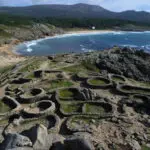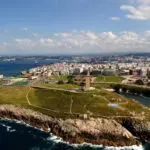Scotland, famous for its misty lochs and ancient castles, also cradles a rich spiritual heritage. Located in the Inner Hebrides is the tranquil island of Iona, a beacon of Christianity and a testament to the spirit of medieval Celtic Christianity, a religious life that championed monastic living. Known as the ‘Cradle of Christianity’ in Scotland, Iona offers history, spirituality, and immense natural beauty.
As you tread the ancient Pilgrim Ways, the past seems to echo on the windswept shores and verdant meadows. The legacy of St Columba, an Irish prince turned missionary monk, reverberates through the centuries. As you explore this holy island, you’ll be struck by the serenity of the place, which soothes the soul and offers revitalization – Iona is a far cry from the bustling urban centres where many of us live today.
This blog acts as an introduction to the wonders of Iona and explores the profound impact of St Columba’s missionary zeal. Whether you journey to Iona as a seeker of historical truths, a lover of pristine areas of natural beauty, or a pilgrim yearning for something more spiritual, Iona promises an experience you won’t forget.
If you would like to travel along one of Scotland’s most enchanting pilgrimage routes with experts taking care of the planning and accommodation, consider booking a place on our St Cuthbert Way to Holy Isle Tour.

Iona: The Cradle of Christianity in Scotland
Iona, a small island found off the coast of Mull in the Inner Hebrides, is fondly dubbed as ‘The Cradle of Christianity’ in Scotland. This magnificent island, measuring merely 1.5 miles wide by 3 miles long, played host to St Columba, who established a monastery here, laying the foundation of Christianity in the region.
Despite its small population of 120 residents, Iona’s charm transcends borders, drawing around 130,000 visitors annually. Known for its peaceful ambiance, it has become a place of spiritual rejuvenation for many.
St Columba: The Beacon of Faith
Columba, born into Irish nobility, embraced a life of piety, becoming a priest and a missionary monk. Before finding solace on Iona, he founded monastic houses in Ireland. In 563 AD, along with twelve companions, Columba reached Iona’s shores, a land then occupied by fellow Scots from Ireland.
Over the next 34 years, they embarked on a missionary crusade across the Western Isles and northeastern Scotland. Remnants of their humble abode still stand today as a testament to their devout, monastic lives. They lived among the local pagan communities, sharing the gospel and their way of life to draw others closer to the Christian faith.
Though Columba passed away in 597 AD, his disciples continued his noble mission, spreading the faith far beyond Iona to northern England and continental Europe. While Roman Christianity flourished in Britain, the Celtic Christian tradition, sparked by Columba, continued to thrive on Iona. In the 9th century, Columba’s remains were relocated to Dunkeld, marking a shift in the epicenter of Scottish Christianity to St. Andrews.
(For those inspired by the lives of the Saints, you may also be interested in exploring the Italian pilgrimage routes linked to St Francis of Assisi. Browse our Italian Walking Tours.)
The Iona Community: A Modern-day Sanctuary
The Iona Community, a dispersed Christian ecumenical group, tirelessly works towards peace, social justice, community rebuilding, and worship renewal. This diverse community, comprising members from varied backgrounds and traditions, is a radical movement committed to embodying the Christian faith in the realms of justice and peace.

Visitor Experience
Embarking on a journey to Iona can feel like stepping back in time, where the humdrum of modern life fades, and the timeless allure of history and spirituality takes center stage. As you set foot on this sacred isle, the tranquil atmosphere offers an immediate sense of peace.
Accommodations on Iona are cozy and welcoming, ranging from quaint bed-and-breakfasts to well-appointed guesthouses. With a community that cherishes its historical legacy, visitors are often greeted with warm Scottish hospitality and stories of the island’s rich past.
Iona is also a good place to try traditional foods, with local eateries offering an array of Scottish delicacies. From freshly caught seafood to traditional Scottish fares like Haggis, there’s a hearty meal awaiting to satiate the appetite of every pilgrim.
The island also offers plenty of guided tours and walking routes, where seasoned guides narrate the tales of St. Columba and the ancient monastery, creating a vivid picture of the island’s spiritual past and present.
Whether wandering through the ruins of the ancient abbey, participating in a local prayer service, or simply embracing the wild, natural landscapes, Iona offers a unique blend of spiritual, historical, and outdoor experiences.

Traveling to Iona
Travelers from various parts of Scotland or the UK can travel to Oban, the gateway to the Western Isles.
From Oban, a ferry ride takes you to the Isle of Mull. As the ferry glides through the crystal-clear waters, the majestic panorama of the Hebrides unfolds. Upon reaching Mull, a scenic drive across the island leads to Fionnphort, from where another short ferry ride transports you to the tranquil shores of Iona.
The transportation services are reliable, with scheduled ferry services making the journey relatively straightforward. However, it’s advisable to check the ferry timetables in advance, especially during the winter when services are limited and adverse weather conditions can affect the service.
Travelers are encouraged to remain respectful when on the island, conscious of the spiritual nature of the site and the religious reasons that inspire many to make the journey.
Vehicles are restricted on Iona to preserve its tranquility, so visitors are expected to explore the island on foot, as pilgrims have done for centuries.
The journey to Iona, though requiring some planning, is part of the pilgrimage, setting the stage for the spiritual exploration that lies ahead on this ancient and sacred isle.

Scotland’s 14 Pilgrim Ways: Trails of Devotion
Scotland boasts a network of 14 long-distance pilgrim paths, stretching from the Borders to the Northern Isles. The Scottish Pilgrim Routes Forum has dedicated a decade to reviving and marking these ancient trails.
Among the restored paths are St Magnus, Whithorn, Borders Abbeys, and St Cuthbert’s Way, with the Fife Pilgrim and Forth to Farne Ways being the latest additions welcoming walkers on a journey of spiritual exploration.
- St Cuthbert’s Way – Melrose to Lindisfarne
- St Magnus Way – Orkney
- St Oswald’s Way – Northumberland
- Fife Pilgrim Way – Culross to St Andrews
- Whithorn Way – Glasgow to Whithorn
- Forth to Farne Way – North Berwick to Lindisfarn
- St Munn’s Way – Cowal Peninsula Argyll
- St Kentigern Way (aka St Mungo) – Solway Firth to Glasgow
- Northern Pilgrims Way – Tain to Kirkwall
- Three Saints Way – Killin to Saint Andrews
- Deeside Way – Aberdeen to Ballater
- Dalriada Way – Tarbert to Luing
- Iona to Killin – to eventually connect Iona to St Andrews
- St Conan’s Way – Dalmally to Iona
(Want to explore pilgrimage routes beyond the UK? Browse Walk the Camino’s full range of Self-Guided Pilgrimage Tours. We have Walking Tours in Spain, Portugal, and France, among other international walking tours.
Begin Your Walking Adventure
Iona, though modest in size, stands as a testament to Scotland’s rich spiritual heritage. Embarking on a pilgrimage to Iona isn’t merely a physical journey but potentially a voyage of the soul. On this sacred land, you can find community, peace, and plenty of atmospheric spots to sit and contemplate the natural world’s beauty.
We hope the Iona’s profound spiritual legacy inspires you to begin your exploration of Scotland’s Christian heritage. If you are ready to set off on your own pilgrimage or epic walk, consider Walk the Camino’s Walking Tours and Pilgrim Experiences.
If you have any questions, please get in touch.








